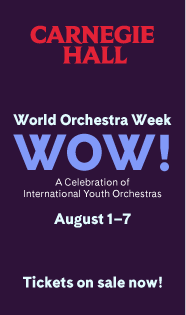LOTNY’s puppet opera serves up Haydn in plain and charming sight

There seem to be ever more puppets showing up in opera houses nowadays in works for which they were never intended.
For Haydn, however, they were de rigueur, given that his chief patron Prince Nikolaus I of Eszterházy had a marionette theatre at his summer residence. On Friday evening, The little OPERA theatre of ny (LOTNY) presented the first of Hadyn’s twelve puppet operas, Jupiter’s Journey to the Earth, in a charming, captivating performance at the Baryshnikov Arts Center.
Nikolaus I established his puppet theater at Eszterházy in 1772, for which he had a special building constructed to house it. It fell to Haydn, who had been in the prince’s service since 1761, to compose music to accompany the puppet productions. Jupiter’s Journey to the Earth, originally entitled Philemon und Baucis oder Jupiters Reise auf die Erde, was presented during a visit by the Empress Maria Theresa to the palace in 1773.
Jupiter’s Journey to the Earth is actually a singspiel, a form of opera which combines spoken dialogue with singing. They generally have plots which contain elements of myth, magic, fantastic creatures, and clearcut stories of good versus evil. Haydn based his first puppet opera on one of the few Greek myths which have a happy ending, the story of Philemon and Baucis.
It begins with the gods bemoaning the sorry state of human affairs. Zeus and Hermes decide to descend to earth disguised as poor travelers to gauge the situation for themselves. Rebuffed by everyone they encounter, they lose all hope for humanity until they are welcomed into the hut of Philemon and Baucis.
The poor couple offer what hospitality they can to the gods. They also relate the loss of their son Aret and his wife Narcissa, who were killed by a bolt of lightning. Zeus and Hermes are moved by their story and restore Aret and Narcissa to life amid generally rejoicing.
Philip Shneidman, who founded LOTNY in 2004, directed the production. He kept things simple which suited the black-box Jerome Robbins Theater in the Baryshnikov Arts Center, as well as the piece itself. When it came to the visual elements, Shneidman’s focus was clearly on the puppets, which were conceived and created by puppeteer Maria Camia and costume designer Lara de Bruijn.
The bickering, self-satisfied, four-eyed gods wore colorful, massive stylized headpieces. As they bobbed about on stage during the overture most bewailed the human’s disregard for the environmental. Others were more indulgent, such as Bacchus suggesting that people needed to drink more wine and Venus cooing what they needed was more love. None of this was in the score and was most likely a rather forced attempt at relevancy by inserting references to climate change. Since it couldn’t be comprehended, it was merely an annoyance.
Once Zeus and Mercury descend to earth, the actual puppets made their appearance. These were fantastic, yet realistic creations which captured the essence of gods and human alike. They glided across the stage assisted by a team of six-puppeteers, generating a depth of emotion equal to that of the singers who stood beside them. One of the most magic moments was when the gods assumed human form by simply tossing hooded capes over themselves.
Two other stage elements were particularly imaginative and effective. One was the pop-up picture book which Baucis opened to show the gods images of Aret and Narcissa. Its childlike simplicity comporting with the aesthetics of the production, while effortlessly expressing the sadness of the proud, bereaved parents. The other was a floor mat, which was at first a drab green and brown and when reversed depicted a carpet of flowers on a green meadow. Not only Aret and Narcissa had been restored to life, but earth also.
Haydn’s score for Jupiter’s Journey to the Earth is a frothy mix of instrumental pieces, arias, and vocal ensembles which hearken back to the Baroque. Bass Gregory Sheppard, obviously a bit under the weather, led the cast as Jupiter. He was nonetheless as stalwart and imperious dramatically as he was resonant and commanding vocally. Rebecca Marchan-Espino with her fresh, lovely mezzo-soprano voice was a perky Mercury, quick to needle and nudge Jupiter down the path of compassion.
The fine tenor Brian Downen was an eloquent if somewhat disheartened Philemon. As his wife, Jennifer Roderer’s warm, rich voice and vivid presence was the essence of humanity. Haydn wrote some of the loveliest music in the piece for Aret and Narcissa, which the vibrant tenor David Morgans and the enchanting soprano Sara Lemesh sang with gleaming youthful tone. Lemesh was particularly impressive tossing off roulades and trills after her Narcissa was restored to life.
Elliott Figg, who conducted from the harpsichord, led a stylish performance full of sparkle and emotion. In a production where bright colors and fascinating objects could have overwhelmed, Figg and his players never let that happen. Especially Kelsey Burnham, who played Haydn’s lovely traverso, or baroque flute, melodies so beautifully.
Too bad they had to compete with the din of voices during the overture.
Jupiter’s Journey to the Earth will be repeated 2 p.m. and 6 p.m. Saturday and 2 p.m. Sunday. lotny.org
